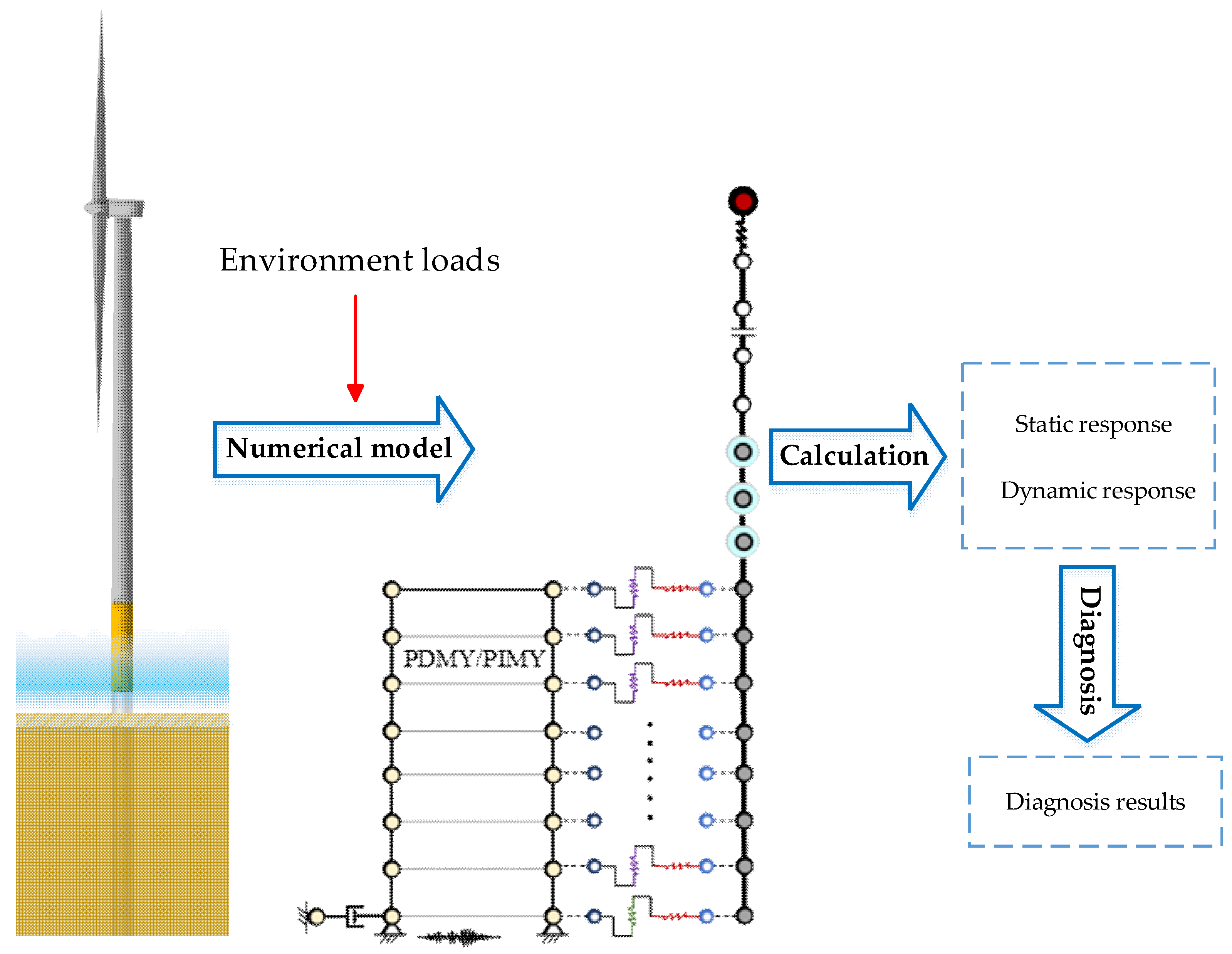An Overview on Structural Health Monitoring and Fault Diagnosis of Offshore Wind Turbine Support Structures
Abstract
1. Introduction
2. Strategies and Challenges in SHM of OWT Support Structures
2.1. SHM Strategies of OWT Towers
- Vibration
- 2.
- Cracks
- 3.
- Tower bending moment
- 4.
- Tower flange connection bolts inspection
- 5.
- Tower weld seam monitoring
- 6.
- Bolt inspection of tower and foundation connection
2.2. SHM Strategies of OWT Foundations
- Vibration
- 2.
- Displacement
- 3.
- Axial forces and bending moments
- 4.
- Corrosion and cracks
- 5.
- Scouring
- 6.
- Grouted connections
- 7.
- Marine growth
2.3. Challenges in SHM of OWT Support Structures
- The challenging offshore environment leads to a significant probability of sensor failures within the monitoring system, resulting in data loss and posing formidable challenges for subsequent data analysis and processing. It is imperative to enhance the reliability of the monitoring system and design a resilient monitoring system.
- Monitoring typically involves the assessment of parameters such as acceleration, strain, and displacement, leading to the generation of highly diverse monitoring data. This poses a significant challenge for data analysis and makes it arduous to assess the service status of OWTs using multi-source heterogeneous monitoring data.
- The health monitoring of OWT support structures can slash operation and maintenance costs while reducing the number of days required for troubleshooting and repairs.
- The number of OWT support structures being monitored in wind farms is restricted, and the monitoring process may not be continuous. The monitoring cycles of various projects vary distinctly, ranging from testing intervals of 1 to 5 years. Long-term real-time monitoring needs to be paid more attention for future progress.
- The offshore real-time data transmission network limits the intelligent development of the monitoring system. Currently, there is limited real-time and intelligent capability, with only a few wind farms achieving the automated real-time monitoring of OWT support structures.
- Given the current primitive state of intelligence in this field, the data processing for wind farm health monitoring and maintenance necessitates a high degree of professionalism from personnel. Currently, there is a scarcity of specialized teams capable of meeting these demands.
3. Fault Diagnosis of OWT Support Structures
3.1. Model-Based Fault Diagnosis
3.2. Vibration-Based Fault Diagnosis Methods
3.3. Artificial Intelligence Methods
3.4. Hybrid Fault Diagnosis Methods
4. Discussion
- While the monitoring of OWT farms may be not conducted in real time, it serves as an assessment of the operational and maintenance status of OWT support structures using monitoring data. However, there is a lack of research on long-term vibration monitoring to evaluate OWT support structures safety, indicating significant potential for future development in this area.
- The current level of real-time diagnosis and alarming is relatively low. Current monitoring or fault diagnosis only assesses the current OWT support structures status and lacks the ability to predict potential future failures. Predicting failures based on current monitoring data is crucial and there is ample room for future advancements.
- It is also crucial to combine diagnosis results to develop reasonable overhaul or operation and maintenance strategies. This can significantly reduce operation and maintenance expenses and time for offshore wind farms.
- The current level of real-time monitoring is limited. It requires a significant amount of time to diagnose OWT support structures using monitoring data, numerical simulations, or artificial intelligence. This results in a delay in fault diagnosis and an inability to promptly address the service status.
- Current research mainly focuses on monitoring damage through frequency changes, but there is still a lack of research on how to quantify the relationship between frequency and damage, such as cracks. In addition, further research is needed on foundation stiffness during storms and the distinction between temporary and permanent changes, in order to obtain data on permanent stiffness changes, which is crucial for evaluating the status of OWT support structures.
- OWT support structure monitoring data provide important data support for its remaining lifespan and strategic choices after decommissioning it. Therefore, it is essential to conduct in-depth exploration of the characteristics of OWT support structures, utilizing the monitoring data.
- In the future, artificial intelligence technology holds great potential for OWT support structures monitoring and fault diagnosis, particularly in the development of remote intelligent monitoring and fault warning platforms. These platforms can assist wind power operation and maintenance personnel in quickly assessing the operational status of wind turbines, issuing advance warnings for OWT support structure malfunctions, and ultimately preventing significant economic losses.
5. Conclusions
- The monitoring and fault diagnosis of OWTs are of utmost significance, as they not only reduce operational and maintenance costs for OWT farms, but also provide technical support for the performance evaluation of supporting structures at the end of their service life [90].
- Utilizing modal parameters changes for OWT support structure fault identification is widely adopted; however, the accuracy of modal parameter identification requires stringent conditions, and identification is greatly influenced by environmental interference and OWT operational loads.
- The real-time monitoring and fault diagnosis of wind farms are essential and require further development in the future. Digital twin holds great potential for growth. Utilizing machine learning for fault recognition can be time-consuming and the processing and utilization efficiency of real-time data remains relatively low. Furthermore, there is a scarcity of databases accessible to all parties involved in wind power, hindering the optimization of fault diagnosis methods.
Author Contributions
Funding
Institutional Review Board Statement
Informed Consent Statement
Data Availability Statement
Acknowledgments
Conflicts of Interest
References
- Antoniadou, I.; Dervilis, N.; Papatheou, E.; Maguire, A.E.; Worden, K. Aspects of structural health and condition monitoring of offshore wind turbines. Philos. Trans. R. Soc. A Math. Phys. Eng. Sci. 2015, 373, 20140075. [Google Scholar] [CrossRef] [PubMed]
- Beganovic, N.; Söffker, D. Structural health management utilization for lifetime prognosis and advanced control strategy deployment of wind turbines: An overview and outlook concerning actual methods, tools, and obtained results. Renew. Sustain. Energy Rev. 2016, 64, 68–83. [Google Scholar] [CrossRef]
- Tautz-Weinert, J.; Watson, S.J. Using SCADA data for wind turbine condition monitoring—A review. IET Renew. Power Gener. 2017, 11, 382–394. [Google Scholar] [CrossRef]
- Márquez, F.P.G.; Tobias, A.M.; Pérez, J.M.P.; Papaelias, M. Condition monitoring of wind turbines: Techniques and methods. Renew. Energy 2012, 46, 169–178. [Google Scholar] [CrossRef]
- Amirat, Y.; Benbouzid, M.E.H.; Al-Ahmar, E.; Bensaker, B.; Turri, S. A brief status on condition monitoring and fault diagnosis in wind energy conversion systems. Renew. Sustain. Energy Rev. 2009, 13, 2629–2636. [Google Scholar] [CrossRef]
- Xia, J.J.; Zou, G. Operation and maintenance optimization of offshore wind farms based on digital twin: A review. Ocean Eng. 2023, 268, 113322. [Google Scholar] [CrossRef]
- Martinez Luengo, M.; Kolios, A. Failure mode identification and end of life scenarios of offshore wind turbines: A review. Energies 2015, 8, 8339–8354. [Google Scholar] [CrossRef]
- Wang, M.M.; Wang, C.Y.; Hnydiuk-Stefan, A.; Feng, S.Z.; Atilla, I.; Li, Z.X. Recent progress on reliability analysis of offshore wind turbine support structures considering digital twin solutions. Ocean Eng. 2021, 232, 109168. [Google Scholar] [CrossRef]
- Mendes, P.; Correia, J.A.; Mourão, A.; Pereira, R.; Fantuzzi, N.; De Jesus, A.; Calçada, R. Fatigue assessments of a jacket-type offshore structure based on static and dynamic analyses. Pract. Period. Struct. Des. Constr. 2021, 26, 04020054. [Google Scholar] [CrossRef]
- Zhu, Q.X.; Wang, H.; Spencer, B.F., Jr. Investigation on vibration behavior of a high-speed railway bridge based on monitoring data. Smart Struct. Syst. 2023, 31, 585–599. [Google Scholar] [CrossRef]
- Zhu, Q.X.; Wang, H.; Zhu, X.J.; Spencer, B.F., Jr. Investigation on the pattern for train-induced strains of a long-span steel truss railway bridge. Eng. Struct. 2023, 275, 115268. [Google Scholar] [CrossRef]
- Sajedi, S.; Liang, X. Deep generative Bayesian optimization for sensor placement in structural health monitoring. Comput.-Aided Civ. Infrastruct. Eng. 2022, 37, 1109–1127. [Google Scholar] [CrossRef]
- Liu, Y.; Hajj, M.; Bao, Y. Review of robot-based damage assessment for offshore wind turbines. Renew. Sustain. Energy Rev. 2022, 158, 112187. [Google Scholar] [CrossRef]
- Chou, J.S.; Ou, Y.C.; Lin, K.Y. Collapse mechanism and risk management of wind turbine tower in strong wind. J. Wind Eng. Ind. Aerodyn. 2019, 193, 103962. [Google Scholar] [CrossRef]
- Yamaguchi, A.; Danupon, S.; Ishihara, T. Numerical prediction of tower loading of floating offshore wind turbine considering effects of wind and wave. Energies 2022, 15, 2313. [Google Scholar] [CrossRef]
- Fan, W.; Qiao, P.Z. Vibration-based damage identification methods: A review and comparative study. Struct. Health Monit. 2011, 10, 83–111. [Google Scholar] [CrossRef]
- Kim, H.C.; Kim, M.H.; Choe, D.E. Structural health monitoring of towers and blades for floating offshore wind turbines using operational modal analysis and modal properties with numerical-sensor signals. Ocean Eng. 2019, 188, 106226. [Google Scholar] [CrossRef]
- Kim, W.; Yi, J.H.; Kim, J.T.; Park, J.H. Vibration-based structural health assessment of a wind turbine tower using a wind turbine model. Procedia Eng. 2017, 188, 333–339. [Google Scholar] [CrossRef]
- Zhou, L.; Li, Y.; Liu, F.S.; Jiang, Z.Q.; Yu, Q.X.; Liu, L.J. Investigation of dynamic characteristics of a monopile wind turbine based on sea test. Ocean Eng. 2019, 189, 106308. [Google Scholar] [CrossRef]
- Gansel, R.; Maier, H.J.; Barton, S. Detection and characterization of fatigue cracks in butt welds of offshore structures using the eddy current method. J. Nondestruct. Eval. Diagn. Progn. Eng. Syst. 2023, 6, 021001. [Google Scholar] [CrossRef]
- He, M.J.; Bai, X.; Ma, R.L.; Huang, D.P. Structural monitoring of an onshore wind turbine foundation using strain sensors. Struct. Infrastruct. Eng. 2019, 15, 314–333. [Google Scholar] [CrossRef]
- Cicero, S.; Lacalle, R.; Cicero, R. Estimation of the maximum allowable lack of penetration defects in circumferential butt welds of structural tubular towers. Eng. Struct. 2009, 31, 2123–2131. [Google Scholar] [CrossRef]
- Capaldo, M.; Orsatelli, J.B.; Curt, J.; Julan, E. Influence of cracks on the buckling of wind turbine towers. J. Phys. Conf. Ser. 2020, 1618, 022001. [Google Scholar] [CrossRef]
- Civera, M.; Surace, C. Non-Destructive Techniques for the Condition and Structural Health Monitoring of Wind Turbines: A Literature Review of the Last 20 Years. Sensors 2022, 22, 1627. [Google Scholar] [CrossRef] [PubMed]
- Santos, F.D.N.; Noppe, N.; Weijtjens, W.; Devriendt, C. Data-driven farm-wide fatigue estimation on jacket foundation OWTs for multiple SHM setups. Wind Energy Sci. Discuss. 2022, 7, 299–321. [Google Scholar] [CrossRef]
- Jay, A.; Myers, A.T.; Mirzaie, F.; Mahmoud, A.; Torabian, S.; Smith, E.; Schafer, B.W. Large-scale bending tests of slender tapered spirally welded steel tubes. J. Struct. Eng. 2016, 142, 04016136. [Google Scholar] [CrossRef]
- Yadav, K.K.; Gerasimidis, S. Instability of thin steel cylindrical shells under bending. Thin-Walled Struct. 2019, 137, 151–166. [Google Scholar] [CrossRef]
- Fajuyitan, O.K.; Sadowski, A.J. Imperfection sensitivity in cylindrical shells under uniform bending. Adv. Struct. Eng. 2018, 21, 2433–2453. [Google Scholar] [CrossRef]
- Guo, L.H.; Yang, S.J.; Jiao, H. Behavior of thin-walled circular hollow section tubes subjected to bending. Thin-Walled Struct. 2013, 73, 281–289. [Google Scholar] [CrossRef]
- Blachowski, B.; Gutkowski, W. Effect of damaged circular flange-bolted connections on behaviour of tall towers, modelled by multilevel substructuring. Eng. Struct. 2016, 111, 93–103. [Google Scholar] [CrossRef]
- Liu, Z.C.; Huang, X.B.; Zhao, L.; Wen, G.R.; Feng, G.Z.; Zhang, Y. Research on online monitoring technology for transmission tower bolt looseness. Measurement 2023, 223, 113703. [Google Scholar] [CrossRef]
- Liu, P.T.; Wang, X.P.; Wang, Y.Q.; Zhu, J.; Ji, X.Y. Research on percussion-based bolt looseness monitoring under noise interference and insufficient samples. Mech. Syst. Signal Process. 2024, 208, 111013. [Google Scholar] [CrossRef]
- Liang, D.; Yuan, S.F. Decision fusion system for bolted joint monitoring. Shock Vib. 2015, 2015, 592043. [Google Scholar] [CrossRef]
- Ji, X.D.; Zou, T.; Bai, X.; Niu, X.B.; Tao, L.B. Fatigue assessment of flange connections in offshore wind turbines under the initial flatness divergence. Front. Energy Res. 2023, 11, 1127957. [Google Scholar] [CrossRef]
- Cheng, L.; Yang, F.; Winkes, J.S.; Veljkovic, M. The C1 wedge connection in towers for wind turbine structures, tensile behaviour of a segment test. Eng. Struct. 2023, 282, 115799. [Google Scholar] [CrossRef]
- Li, S.Z.; Li, H.; Zhou, X.H.; Wang, Y.H.; Li, X.H.; Gan, D.; Zhu, R.H. Damage detection of flange bolts in wind turbine towers using dynamic strain responses. J. Civ. Struct. Health Monit. 2023, 13, 67–81. [Google Scholar] [CrossRef]
- He, X.L.; Tianli, S. A new identification method for bolt looseness in wind turbine towers. Shock Vib. 2019, 2019, 6056181. [Google Scholar] [CrossRef]
- Pekedis, M.; Mascerañas, D.; Turan, G.; Ercan, E.; Farrar, C.R.; Yildiz, H. Structural health monitoring for bolt loosening via a non-invasive vibro-haptics human-machine cooperative interface. Smart Mater. Struct. 2015, 24, 085018. [Google Scholar] [CrossRef]
- Yang, X.Y.; Gao, Y.Q.; Fang, C.; Zheng, Y.; Wang, W. Deep learning-based bolt loosening detection for wind turbine towers. Struct. Control Health Monit. 2022, 29, e2943. [Google Scholar] [CrossRef]
- Nguyen, T.C.; Huynh, T.C.; Ryu, J.Y.; Park, J.H.; Kim, J.T. Bolt-loosening identification of bolt connections by vision image-based technique. Nondestruct. Charact. Monit. Adv. Mater. Aerosp. Civ. Infrastruct. 2016, 9804, 227–243. [Google Scholar] [CrossRef]
- Dai, K.S.; Du, H.; Luo, Y.X.; Han, R.; Li, J. Stress distribution prediction of circular hollow section tube in flexible high-neck flange joints based on the hybrid machine learning model. Materials 2023, 16, 6815. [Google Scholar] [CrossRef] [PubMed]
- Biswal, R.; Al Mamun, A.; Mehmanparast, A. On the performance of monopile weldments under service loading conditions and fatigue damage prediction. Fatigue Fract. Eng. Mater. Struct. 2021, 44, 1469–1483. [Google Scholar] [CrossRef]
- Yue, Y.C.; Tian, J.J.; Bai, Y.T.; Jia, K.; He, J.; Luo, D.; Chen, T.B. Applicability analysis of inspection and monitoring technologies in wind turbine towers. Shock Vib. 2021, 2021, 1–10. [Google Scholar] [CrossRef]
- Farhan, M.; Schneider, R.; Thöns, S. Predictive information and maintenance optimization based on decision theory: A case study considering a welded joint in an offshore wind turbine support structure. Struct. Health Monit. 2022, 21, 185–207. [Google Scholar] [CrossRef]
- Weijtjens, W.; Stang, A.; Devriendt, C.; Schaumann, P. Bolted ring flanges in offshore-wind support structures-in-situ validation of load-transfer behaviour. J. Constr. Steel Res. 2021, 176, 106361. [Google Scholar] [CrossRef]
- Nguyen, T.C.; Huynh, T.C.; Yi, J.H.; Kim, J.T. Hybrid bolt-loosening detection in wind turbine tower structures by vibration and impedance responses. Wind Struct. 2017, 24, 385–403. [Google Scholar] [CrossRef]
- Park, J.H.; Huynh, T.C.; Choi, S.H.; Kim, J.T. Vision-based technique for bolt-loosening detection in wind turbine tower. Wind Struct. 2015, 21, 709–726. [Google Scholar] [CrossRef]
- Xu, M.Q.; Au, F.T.; Wang, S.Q.; Wang, Z.S.; Peng, Q.; Tian, H.Y. Dynamic response analysis of a real-world operating offshore wind turbine under earthquake excitations. Ocean. Eng. 2022, 266, 112791. [Google Scholar] [CrossRef]
- Kim, K.; Kim, H.; Lee, J.; Kim, S.; Paek, I. Design and performance analysis of control algorithm for a floating wind turbine on a large semi-submersible platform. J. Phys. Conf. Ser. 2016, 753, 092017. [Google Scholar] [CrossRef]
- Gorostidi, N.; Pardo, D.; Nava, V. Diagnosis of the health status of mooring systems for floating offshore wind turbines using autoencoders. Ocean Eng. 2023, 287, 115862. [Google Scholar] [CrossRef]
- Ziegler, L.; Cosack, N.; Kolios, A.; Muskulus, M. Structural monitoring for lifetime extension of offshore wind monopiles: Verification of strain-based load extrapolation algorithm. Mar. Struct. 2019, 66, 154–163. [Google Scholar] [CrossRef]
- Mieloszyk, M.; Ostachowicz, W. An application of structural health monitoring system based on FBG sensors to offshore wind turbine support structure model. Mar. Struct. 2017, 51, 65–86. [Google Scholar] [CrossRef]
- Penner, N.; Grießmann, T.; Rolfes, R. Monitoring of suction bucket jackets for offshore wind turbines: Dynamic load bearing behaviour and modelling. Mar. Struct. 2020, 72, 102745. [Google Scholar] [CrossRef]
- Puruncajas, B.; Vidal, Y.; Tutivén, C. Vibration-response-only structural health monitoring for offshore wind turbine jacket foundations via convolutional neural networks. Sensors 2020, 20, 3429. [Google Scholar] [CrossRef] [PubMed]
- Feijóo, M.D.C.; Zambrano, Y.; Vidal, Y.; Tutivén, C. Unsupervised damage detection for offshore jacket wind turbine foundations based on an autoencoder neural network. Sensors 2021, 21, 3333. [Google Scholar] [CrossRef] [PubMed]
- Weijtjens, W.; Verbelen, T.; De Sitter, G.; Devriendt, C. Foundation structural health monitoring of an offshore wind turbine—A full-scale case study. Struct. Health Monit. 2016, 15, 389–402. [Google Scholar] [CrossRef]
- Brijder, R.; Hagen, C.H.; Cortés, A.; Irizar, A.; Thibbotuwa, U.C.; Helsen, S.; Vásquez, S.; Ompusunggu, A.P. Review of corrosion monitoring and prognostics in offshore wind turbine structures: Current status and feasible approaches. Front. Energy Res. 2022, 10, 1–22. [Google Scholar] [CrossRef]
- Schubnell, J.; Carl, E.; Widerspan, V.; Collmann, M. Determination of loading and residual stresses on offshore jacket structures by X-ray diffraction. J. Mar. Sci. Eng. 2023, 11, 1304. [Google Scholar] [CrossRef]
- Kolios, A.; Wang, L.; Mehmanparast, A.; Brennan, F. Determination of stress concentration factors in offshore wind welded structures through a hybrid experimental and numerical approach. Ocean Eng. 2019, 178, 38–47. [Google Scholar] [CrossRef]
- Zhang, P.; He, Z.J.; Cui, C.Y.; Ren, L.; Yao, R. Operational modal analysis of offshore wind turbine tower under ambient excitation. J. Mar. Sci. Eng. 2022, 10, 1963. [Google Scholar] [CrossRef]
- Prendergast, L.J.; Gavin, K.; Doherty, P. An investigation into the effect of scour on the natural frequency of an offshore wind turbine. Ocean Eng. 2015, 101, 1–11. [Google Scholar] [CrossRef]
- Weijtjens, W.; Verbelen, T.; Capello, E.; Devriendt, C. Vibration based structural health monitoring of the substructures of five offshore wind turbines. Procedia Eng. 2017, 199, 2294–2299. [Google Scholar] [CrossRef]
- Wang, X.; Lin, P.; Huang, H.D.; Yuan, J.; Qiu, X.; Liu, X. Scour dynamic properties and online monitoring of offshore wind power foundation. J. Tsinghua Univ. (Sci. Technol.) 2023, 63, 1087–1094. [Google Scholar] [CrossRef]
- Moll, J. Damage detection in grouted connections using electromechanical impedance spectroscopy. Proc. Inst. Mech. Eng. Part C J. Mech. Eng. Sci. 2019, 233, 947–950. [Google Scholar] [CrossRef]
- Brett, C.R.; Gunn, D.A.; Dashwood, B.A.J.; Holyoake, S.J.; Wilkinson, P.B. Development of a technique for inspecting the foundations of offshore wind turbines. Insight-Non-Destr. Test. Cond. Monit. 2018, 60, 19–27. [Google Scholar] [CrossRef]
- Schoefs, F.; O’byrne, M.; Pakrashi, V.; Ghosh, B.; Oumouni, M.; Soulard, T.; Reynaud, M. Fractal dimension as an effective feature for characterizing hard marine growth roughness from underwater image processing in controlled and uncontrolled image environments. J. Mar. Sci. Eng. 2021, 9, 1344. [Google Scholar] [CrossRef]
- Jahjouh, M. The effect of marine growth and damage severity on the modal parameters of offshore wind turbine supporting structures: An experimental study. J. Vibroeng. 2020, 23, 407–418. [Google Scholar] [CrossRef]
- Gao, Z.W.; Liu, X.X. An overview on fault diagnosis, prognosis and resilient control for wind turbine systems. Processes 2021, 9, 300. [Google Scholar] [CrossRef]
- Tewolde, S.; Höffer, R.; Haardt, H. Validated model based development of damage index for structural health monitoring of offshore wind turbine support structures. Procedia Eng. 2017, 199, 3242–3247. [Google Scholar] [CrossRef]
- Li, M.Y.; Kefal, A.; Oterkus, E.; Oterkus, S. Structural health monitoring of an offshore wind turbine tower using iFEM methodology. Ocean Eng. 2020, 204, 107291. [Google Scholar] [CrossRef]
- McAdam, R.A.; Chatzis, M.N.; Kuleli, M.; Anderson, E.F.; Byrne, B.W. Monopile foundation stiffness estimation of an instrumented offshore wind turbine through model updating. Struct. Control Health Monit. 2023, 2023, 4474809. [Google Scholar] [CrossRef]
- Liang, F.Y.; Yuan, Z.C.; Liang, X.; Zhang, H. Seismic response of monopile-supported offshore wind turbines under combined wind, wave and hydrodynamic loads at scoured sites. Comput. Geotech. 2022, 144, 104640. [Google Scholar] [CrossRef]
- Yuan, Z.C.; Liang, F.Y.; Zhang, H.; Liang, X. Seismic analysis of a monopile-supported offshore wind turbine considering the effect of scour-hole dimensions: Insights from centrifuge testing and numerical modelling. Ocean Eng. 2023, 283, 115067. [Google Scholar] [CrossRef]
- Martinez-Luengo, M.; Kolios, A.; Wang, L. Structural health monitoring of offshore wind turbines: A review through the statistical pattern recognition paradigm. Renew. Sustain. Energy Rev. 2016, 64, 91–105. [Google Scholar] [CrossRef]
- Avendaño-Valencia, L.D.; Fassois, S.D. Damage/fault diagnosis in an operating wind turbine under uncertainty via a vibration response Gaussian mixture random coefficient model based framework. Mech. Syst. Signal Process. 2017, 91, 326–353. [Google Scholar] [CrossRef]
- Khadka, A.; Fick, B.; Afshar, A.; Tavakoli, M.; Baqersad, J. Non-contact vibration monitoring of rotating wind turbines using a semi-autonomous UAV. Mech. Syst. Signal Process. 2020, 138, 106446. [Google Scholar] [CrossRef]
- Dong, X.F.; Lian, J.J.; Wang, H.J.; Yu, T.S.; Zhao, Y. Structural vibration monitoring and operational modal analysis of offshore wind turbine structure. Ocean Eng. 2018, 150, 280–297. [Google Scholar] [CrossRef]
- Jeong, S.; Kim, E.J.; Park, J.W.; Sim, S.H. Data fusion-based damage identification for a monopile offshore wind turbine structure using wireless smart sensors. Ocean Eng. 2020, 195, 106728. [Google Scholar] [CrossRef]
- Cevasco, D.; Tautz-Weinert, J.; Smolka, U.; Kolios, A. Feasibility of machine learning algorithms for classifying damaged offshore jacket structures using SCADA data. J. Phys. Conf. Ser. 2020, 1669, 012021. [Google Scholar] [CrossRef]
- Masoumi, M. Machine learning solutions for offshore wind farms: A review of applications and impacts. J. Mar. Sci. Eng. 2023, 11, 1855. [Google Scholar] [CrossRef]
- Gawali, M.B.; Gawali, S.S.; Patil, M. Fault prediction model in wind turbines using deep learning structure with enhanced optimisation algorithm. J. Control Decis. 2023, 1–18. [Google Scholar] [CrossRef]
- Guo, J.X.; Ji, X.; Song, H.; Chang, S.; Liu, F.S. Unsupervised statistical estimation of offshore wind turbine vibration for structural damage detection under varying environmental conditions. Eng. Struct. 2022, 272, 115005. [Google Scholar] [CrossRef]
- Yeter, B.; Garbatov, Y.; Soares, C.G. Life-extension classification of offshore wind assets using unsupervised machine learning. Reliab. Eng. Syst. Saf. 2022, 219, 108229. [Google Scholar] [CrossRef]
- Lian, J.J.; Cai, O.; Dong, X.F.; Jiang, Q.; Zhao, Y. Health monitoring and safety evaluation of the offshore wind turbine structure: A review and discussion of future development. Sustainability 2019, 11, 494. [Google Scholar] [CrossRef]
- Moynihan, B.; Mehrjoo, A.; Moaveni, B.; McAdam, R.; Rüdinger, F.; Hines, E. System identification and finite element model updating of a 6 MW offshore wind turbine using vibrational response measurements. Renew. Energy 2023, 219, 119430. [Google Scholar] [CrossRef]
- Zhang, Z.M.; Sun, C.; Jahangiri, V. Structural damage identification of offshore wind turbines: A two-step strategy via FE model updating. Struct. Control Health Monit. 2022, 29, e2872. [Google Scholar] [CrossRef]
- Liang, F.Y.; Jia, X.J.; Zhang, H.; Wang, C.; Shen, P.P. Seismic responses of offshore wind turbines based on a lumped parameter model subjected to complex marine loads at scoured sites. Ocean Eng. 2024, 297. [Google Scholar] [CrossRef]
- Zheng, H.B.; Zhang, H.; Liang, F.Y.; Li, L. Numerical investigation on lateral monotonic and cyclic responses of scoured rigid monopile based on an integrated bounding surface model. Comput. Geotech. 2024, 166. [Google Scholar] [CrossRef]
- Iliopoulos, A.; Shirzadeh, R.; Weijtjens, W.; Guillaume, P.; Van Hemelrijck, D.; Devriendt, C. A modal decomposition and expansion approach for prediction of dynamic responses on a monopile offshore wind turbine using a limited number of vibration sensors. Mech. Syst. Signal Process. 2016, 68, 84–104. [Google Scholar] [CrossRef]
- Yeter, B.; Garbatov, Y.; Soares, C.G. Review on artificial intelligence-aided life extension assessment of offshore wind support structures. J. Mar. Sci. Appl. 2022, 21, 26–54. [Google Scholar] [CrossRef]
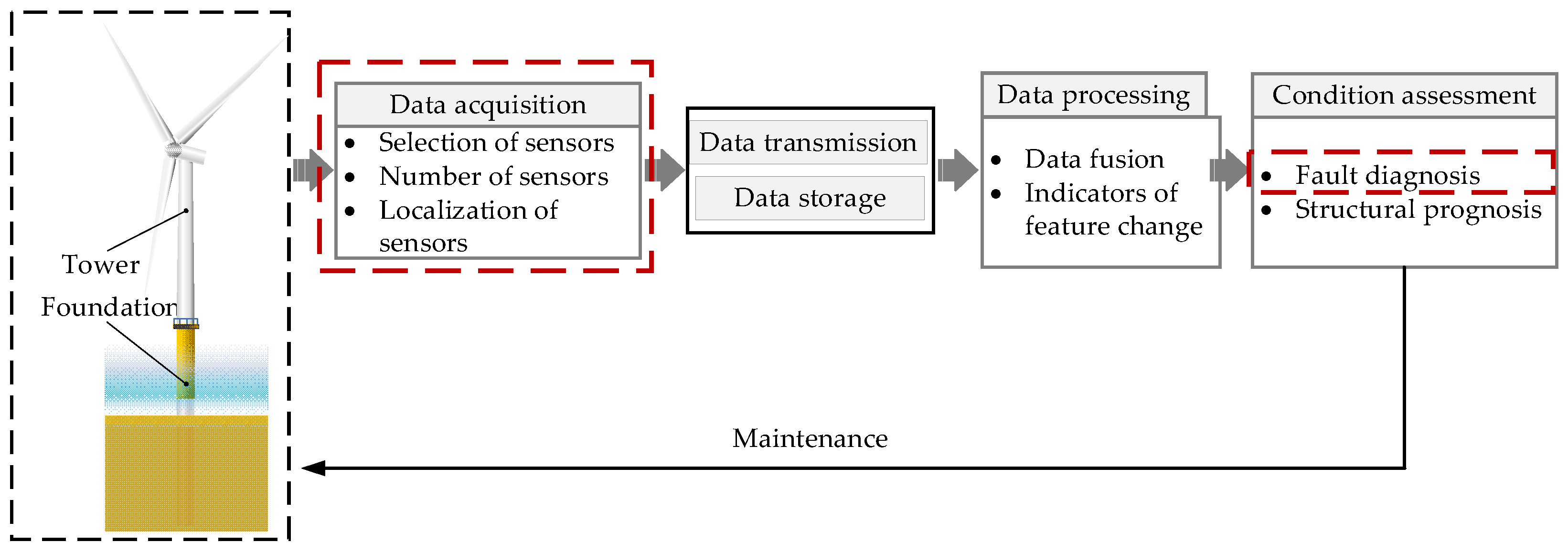
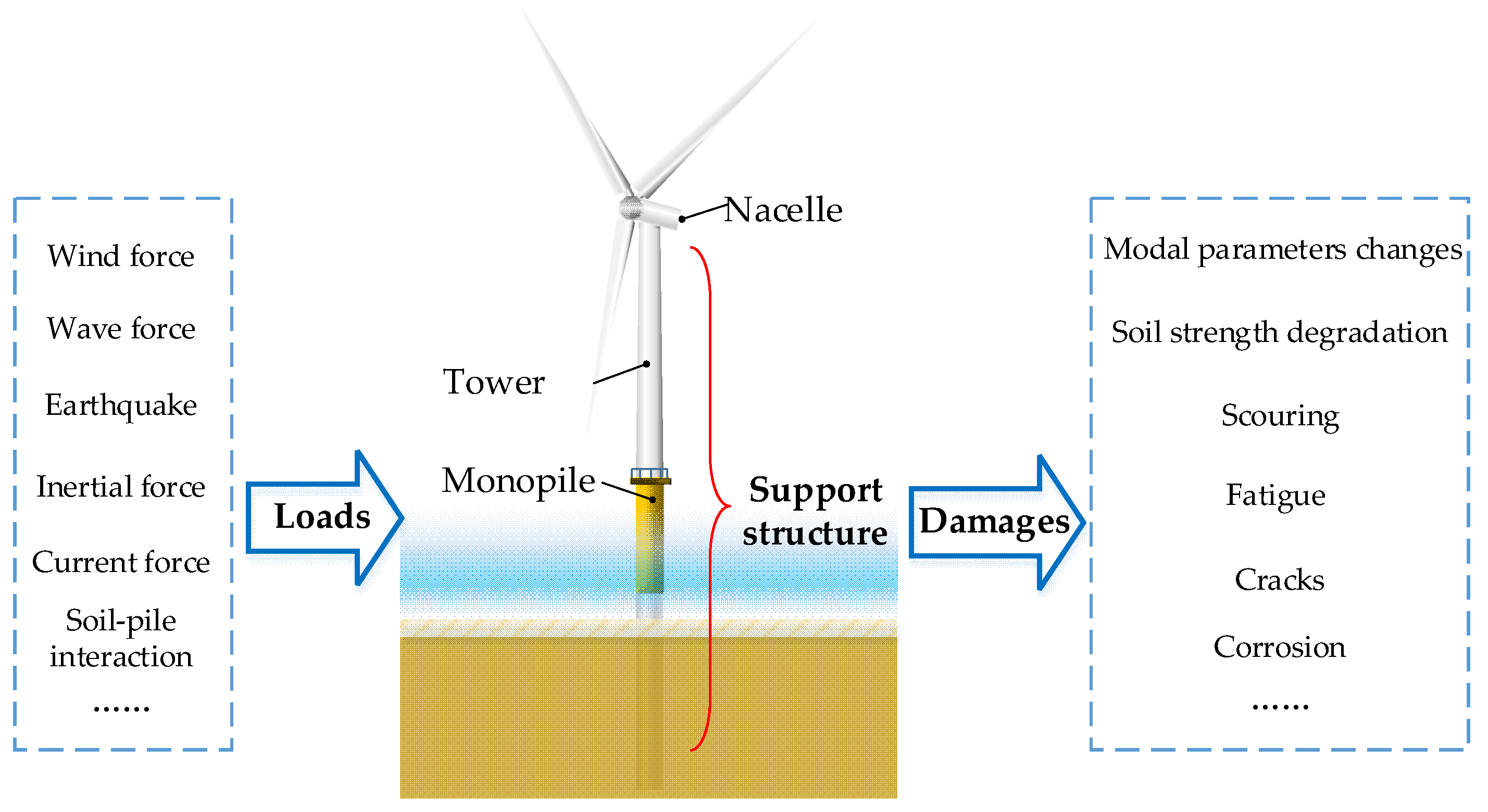
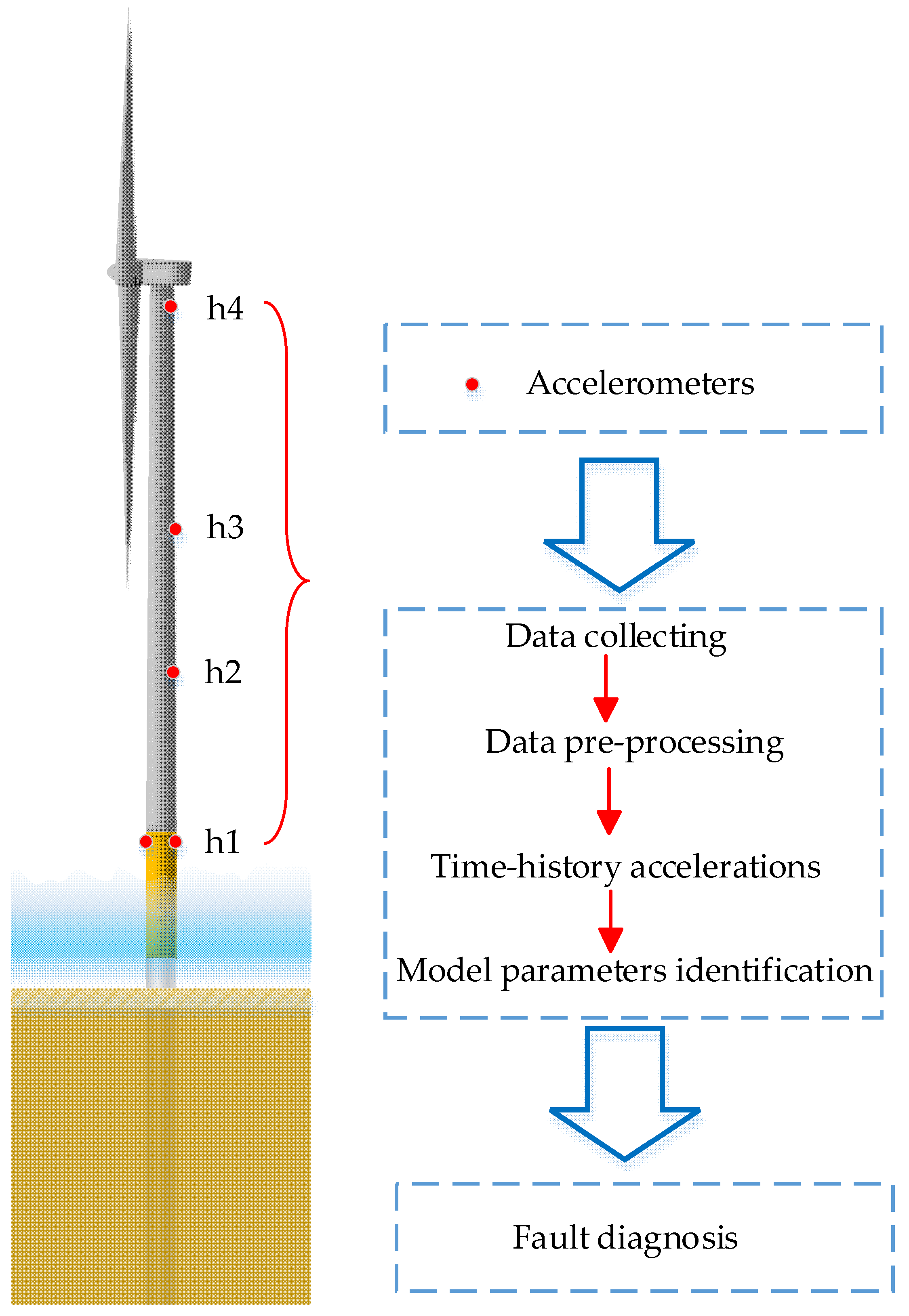
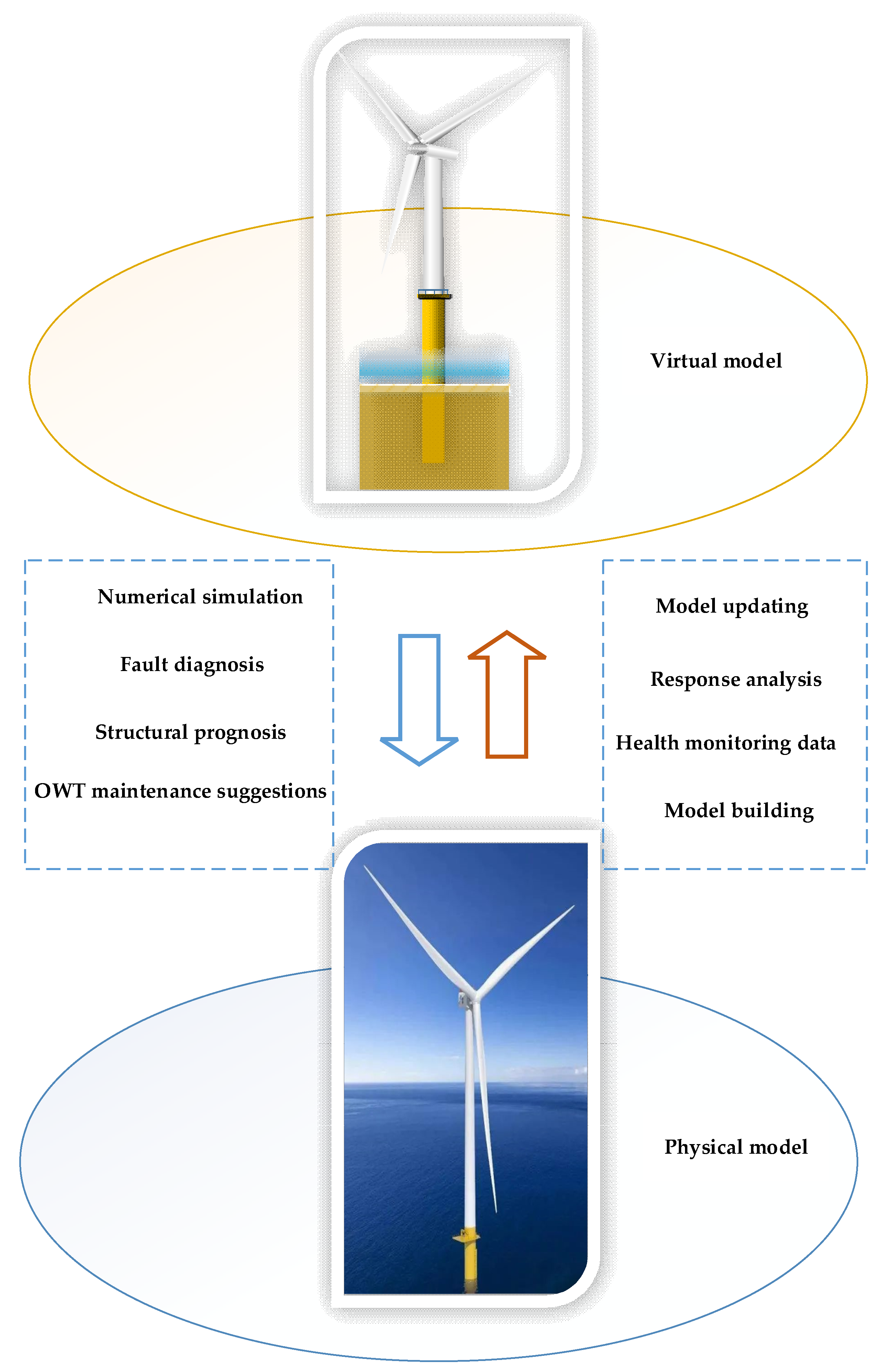
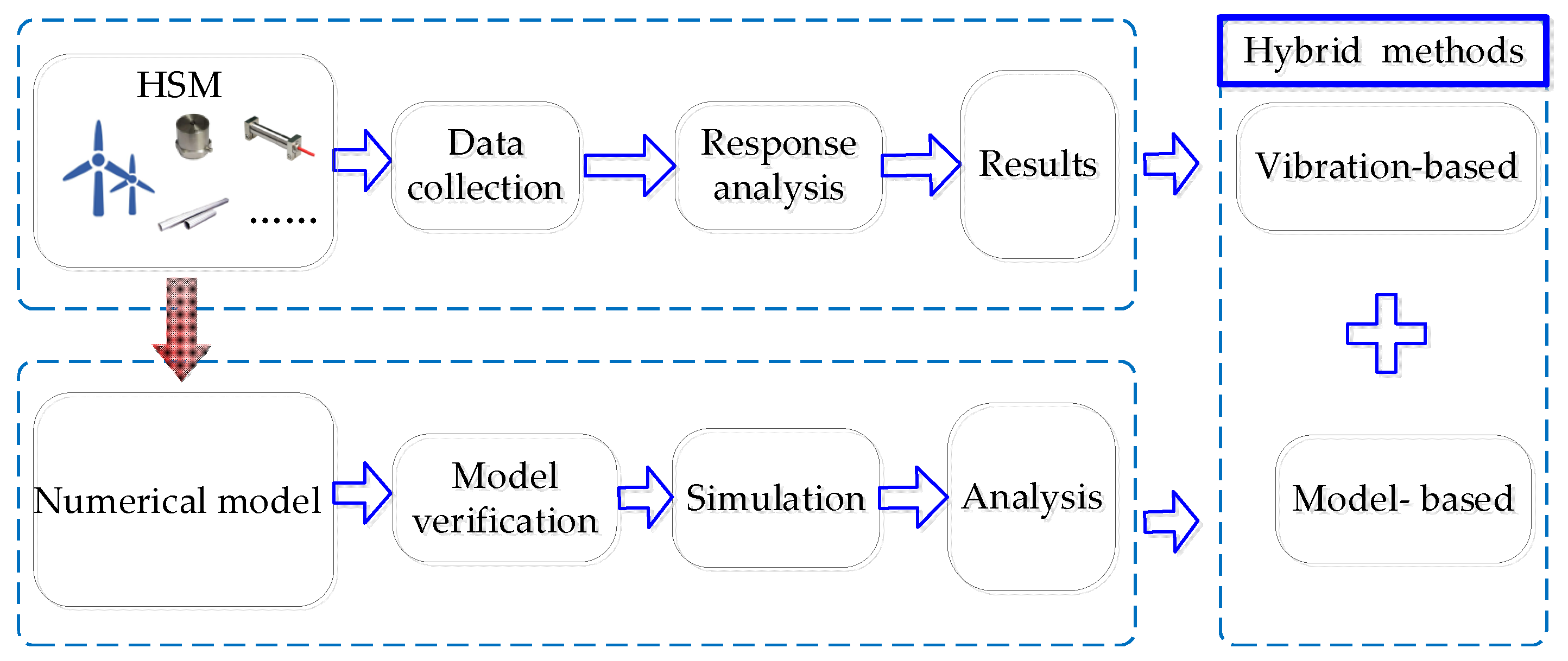
| Methods | Advantages | Disadvantages |
|---|---|---|
| Model-based fault diagnosis | Able to analyze the service status of unmonitored OWT support structures using numerical simulation; The SHM system has a limited number of measurement points and using validated models, information such as acceleration, displacement, and bending moment can be obtained for unmeasured points. | There is a high demand for numerical analysis skills for workers; Modeling takes a long time, as each OWT has a different structure, foundation, and ground environment, requiring separate modeling for analysis; Real-time OWT support structure service status cannot be obtained, requiring a long time for analysis and diagnosis. |
| Vibration-based fault diagnosis methods | It is able to quickly diagnose the service status of OWT support structures using monitoring data; Vibration data can be used to reflect the erosion status of OWT support structures; The vibration characteristics of OWT support structures can be obtained through ship collisions, allowing for multiple monitoring during service. | Only a small number of OWT support structures in wind farms have installed health monitoring systems, limiting health diagnosis to only monitored OWT support structures; The harsh service environment of sensors leads to a high probability of sensor failure and data loss; The modal parameters of OWT support structures are difficult to accurately identify due to environmental loads and rotor rotation. |
| Artificial intelligence methods | It can achieve multi-source and heterogeneous data fusion to determine the service status of OWT; There is significant room for future development, with the potential for real-time intelligent monitoring. | The large volume of data results in time-consuming calculations for machine learning models; A significant amount of data are required for support, yet currently, most offshore wind farm support structure monitoring data remain undisclosed. |
| Hybrid fault diagnosis methods | Combining the advantages of data-driven and physics-based models to compensate for their respective disadvantages; There is significant room for future development. | It is challenging to achieve real-time diagnosis; Professional personnel are required to diagnose faults by combining monitoring data with numerical simulation results. |
Disclaimer/Publisher’s Note: The statements, opinions and data contained in all publications are solely those of the individual author(s) and contributor(s) and not of MDPI and/or the editor(s). MDPI and/or the editor(s) disclaim responsibility for any injury to people or property resulting from any ideas, methods, instructions or products referred to in the content. |
© 2024 by the authors. Licensee MDPI, Basel, Switzerland. This article is an open access article distributed under the terms and conditions of the Creative Commons Attribution (CC BY) license (https://creativecommons.org/licenses/by/4.0/).
Share and Cite
Yang, Y.; Liang, F.; Zhu, Q.; Zhang, H. An Overview on Structural Health Monitoring and Fault Diagnosis of Offshore Wind Turbine Support Structures. J. Mar. Sci. Eng. 2024, 12, 377. https://doi.org/10.3390/jmse12030377
Yang Y, Liang F, Zhu Q, Zhang H. An Overview on Structural Health Monitoring and Fault Diagnosis of Offshore Wind Turbine Support Structures. Journal of Marine Science and Engineering. 2024; 12(3):377. https://doi.org/10.3390/jmse12030377
Chicago/Turabian StyleYang, Yang, Fayun Liang, Qingxin Zhu, and Hao Zhang. 2024. "An Overview on Structural Health Monitoring and Fault Diagnosis of Offshore Wind Turbine Support Structures" Journal of Marine Science and Engineering 12, no. 3: 377. https://doi.org/10.3390/jmse12030377
APA StyleYang, Y., Liang, F., Zhu, Q., & Zhang, H. (2024). An Overview on Structural Health Monitoring and Fault Diagnosis of Offshore Wind Turbine Support Structures. Journal of Marine Science and Engineering, 12(3), 377. https://doi.org/10.3390/jmse12030377












